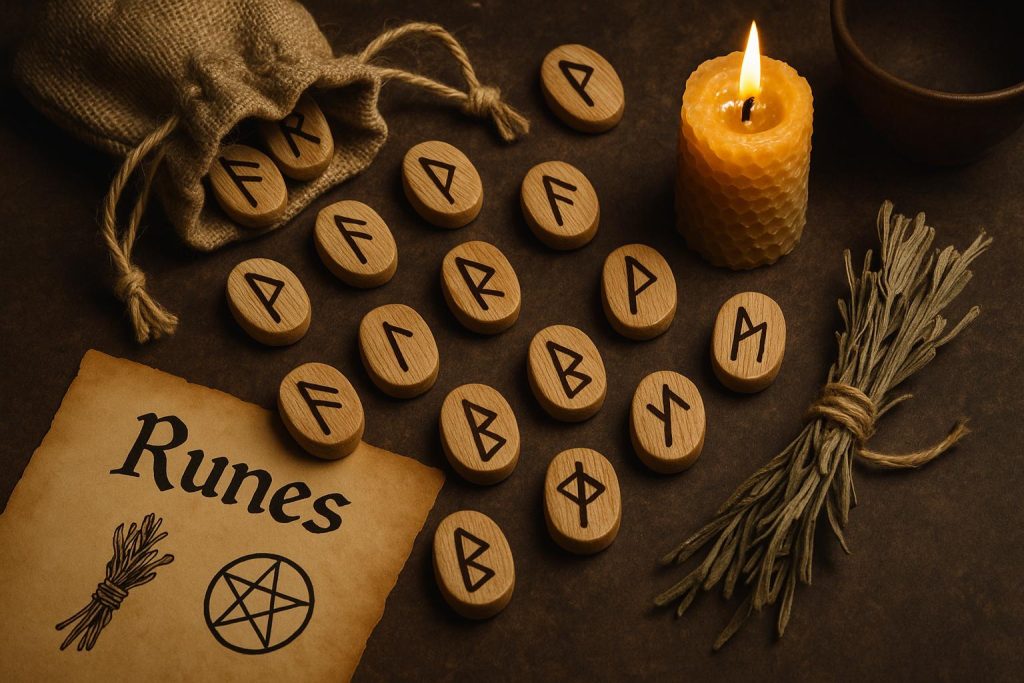
The Historical Context of Runes
Runes have a fascinating history rooted in ancient Germanic tribes who developed alphabets primarily for communication. Among these alphabets, the most prominent and oldest is the Elder Futhark, which originated around the period of 150–800 AD. Initially crafted for mundane activities such as communication, runes gradually evolved for purposes beyond mere transcription. They became instruments not just for expression but also for mystical and divinatory practices. These practices are encapsulated in the term rúnatáls þáttr óðins. This term refers to a particular section within the Old Norse poem “Hávamál,” where the god Odin narrates the tale of how he acquired the knowledge of runes. According to the myth, Odin gained this wisdom following a dramatic act of self-sacrifice, symbolizing the profound power and knowledge runes are believed to hold.
The Structure of Runes
The Elder Futhark consists of a structured set of 24 symbols, each inherent with unique sounds, meanings, and interpretations. These runes are distinguishable from modern alphabetic symbols, as they don’t just symbolize phonetics but also embody various concepts and elements of the world. Commonly, runes were inscribed on materials such as stone, wood, or metal, reflecting the durable nature of their significance. Each rune held a deeper symbolism embedded within its design. Unlike many of today’s alphabets that primarily convey sounds to verbalize language, each rune inherently carried a deep multifaceted symbolism that often extends beyond mere phonetic representation.
Runic Divination
Runic divination thrives as a historical practice that serves to offer insights and guidance on possible futures or to illuminate present circumstances faced by an individual. The process begins with a reflection or a defined question that the seeker brings forth. The diviner, acting as a conduit, draws runes from a bag, placing them in a designated pattern or spread. The drawn runes, each with their distinct interpretations, are meticulously analyzed according to their positions within the layout. The objective is to provide clarity or advice that resonates with the context of the seeker’s query.
This ancient practice transcends a mere fortune-telling approach; rather than predicting concrete events, runic divination offers a tool for inward reflection. The insights obtained are meant to provoke thought and provide introspection into one’s life or decisions. Interpretations can vary significantly, shaped by the particular runes drawn and the methodological preferences of the practitioner. There exists a deep subjectivity intertwined with the interpretive process, acknowledging that personal intuition plays a crucial role in understanding the runes’ message.
Runes in Spellwork
Beyond their role in divination, runes hold a substantive place within the realm of spellwork and magical practices. Enthusiasts and practitioners assert that the symbolic essence of runes can amplify the potency of certain spells or rituals. During rituals, runes are inscribed onto different objects or visualized to resonate with specific intentions and outcomes. This practice is rooted in the belief that runes possess an inherent energy interconnected with various life domains, such as protection, love, prosperity, and success.
In spellwork, runes serve as powerful conduits, energizing a practitioner’s intentions with ancient symbolism. The engraving or visualization of runes in such contexts is based on the notion that these symbols channel distinct energies that can align with particular objectives. This integration of runes into magical practices is less about the literal spellcasting and more about activating symbolic forces believed to support one’s desires and goals.
Ethical Considerations and Modern Adaptations
The application of runes, whether in divination or magical practices, demands a profound appreciation and understanding of their cultural and historical contexts. Respecting these origins becomes paramount, especially considering the revival and modern adaptation of runic practices. Present-day users of runes emphasize the necessity of engaging with these symbols ethically and conscientiously, fostering their use for positive and constructive purposes rather than manipulation or harm.
Modern adaptations also manifest in the neo-pagan or New Age movements that integrate historical practices with personalized symbolism and methods tailored to contemporary beliefs and experiences. Such adaptations make room for the dynamic fusion of tradition with modern spirituality. For instance, some individuals adopt runes into personal philosophies, aligning them with unique spiritual frameworks.
In recent years, there has been a notable resurgence in the curiosity about runic traditions. This renewed interest is facilitated by numerous opportunities for learning and immersion, such as online courses, literature, and workshops. These platforms provide avenues for enthusiasts to deepen their understanding and practice of runes. However, it is vital that engagement with these resources is approached with a combination of open-mindedness and a willingness to honor and respect the historical symbolism and narratives inherent in the runic tradition.
Whether viewed purely historically, mystically, or as a medium for self-reflection, runes continue to captivate interest, symbolizing a bridge between the past and contemporary exploration of ancient wisdom.
